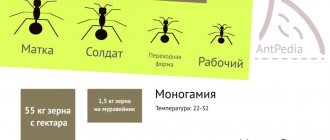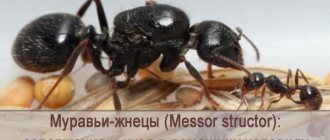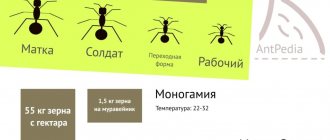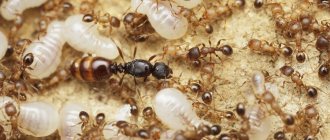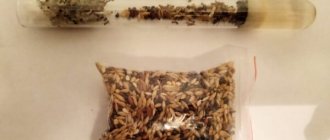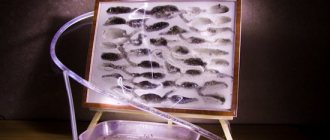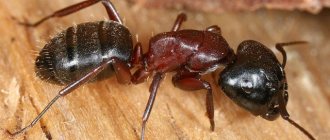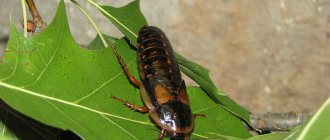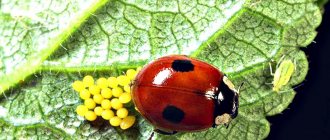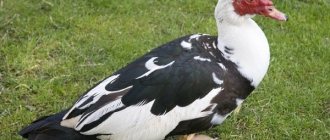Brief information
Name in Latin: Messor structor Difficulty: for beginners Size of individuals: M - workers from 4 to 9 mm, soldiers up to 11 mm, queen up to 12 mm Size of colonies: up to 5,000 individuals Habitat: steppes and semi-deserts, from Portugal to Kazakhstan, and south to Iran Temperature: 23-25 degrees, preferably warmed up Humidity: gradient, from 30% in the arena to 90% in the nest Diet: plant seeds, dead insects Wintering: not required
Identification
Steiner et al. (2018) - Worker and queen. Mostly lighter than Messor ponticus
and
Messor muticus
.
Discrimination from Messor ibericus
,
M. ponticus
, and
Messor mcarthuri
by long 1st funicular segment, by base of scape with rounded lobe, and by coarser sculpture of mesopleuron, from
M. ponticus
by abundant standing setae on side of head.
Head more irregularly costate than in M. mcarthuri
.
Surface of 1st gastral tergite less imbricate than in M. ibericus
and
M. mcarthuri
, similarly to
M. ponticus
and
M. muticus
.
Worker. Similar sized as M. ibericus
and
M. muticus
, smaller than
M. ponticus
and
M. mcarthuri
.
For individuals difficult to discriminate from M. ibericus
,
M. ponticus
, or
M. muticus
using qualitative morphology, linear discriminant functions based on morphometrics is available.
Queen. Larger than M. ibericus
, similarly sized as the other three species.
Discrimination from M. ibericus
by reduced reticulation and rugosity of anepisternum and katepisternum.
Anthill structure
The “houses” of these insects are complex and have a surprisingly well-thought-out structure. More than a million individuals can be in it at the same time. The anthill has several exits, each of which is guarded by “soldiers,” as well as a large number of “production” premises.
- There is a “cow barn” - a chamber for keeping aphids (insects that ants breed and protect).
- Cemetery - a compartment for dead insects and various garbage.
- Barns are places for storing supplies. Moreover, there are several types of barns: for “grain” (plant seeds collected by the reapers are stored here) and for “meat”, where caterpillars, flies or other insects brought are stored.
- Place for the uterus. The queen of the colony lives in her own room, her main task is laying eggs. She is cared for by special working individuals.
- Finally, there are chambers with offspring, where larvae, pupae, eggs and workers monitoring them are located.
Indeed, the structure of the insect colony’s home is striking in its logic.
- Messor aciculatus;
- Messor denticulatus;
- Messor kasakorum;
- Messor rufitarsis;
- Messor constructor.
The genus received the name Messor (reaper) due to the method of collecting grain from the fields. The specificity of nutrition is determined by the nature of vegetation in the desert climate. According to research, ants from one family are able to bring up to 1.5 kg of grain to underground storage facilities. The answer to the question: is the harvester ant a pest that steals the fruits of human labor should be answered in the negative. He harvests his harvest only from the ground, from already damaged spikelets. The grains are stored in moist underground chambers for a long time and periodically germinate. Then the ants chew off the seedlings, and the seeds themselves are ground into powder, moistened with saliva and fed to the larvae.
Reaper ants have their own characteristics:
- large size of individuals;
- peacefulness;
- swarming, nest building in spring.
Let us consider this genus in more detail using the example of the species Messor structor (steppe harvester ant).
Taxonomy
Previously called Messor "structor"
(Latreille, 1798) understood a whole complex of species, which in 2018, in the course of molecular genetic studies of DNA and
Wolbachia
, were divided into 5 separate species: Messor structor (Austria, Bulgaria, Czech Republic, France, Hungary, Romania, Slovenia), M ibericus Santschi, 1925 (Bulgaria, Croatia, France, Germany, Greece, Italy, Romania, Slovenia, Spain, Switzerland), M. muticus (Nylander, 1849) stat.rev. (Armenia, Kazakhstan, Kyrgyzstan, Romania, Russia, Ukraine), and two species new to science, M. ponticus sp.n. (Bulgaria, Romania, Türkiye, Ukraine) and M. mcarthuri sp.n. (Greece, Türkiye).
In 2022, one of the former synonyms, the taxon Messor clivorum Ruzsky, was restored to an independent species status (Steiner et al., 2018) and, presumably, all northern populations of Messor muticus
in Russia belong to this cryptic species
M. clivorum
.
In the same work, the taxon Messor tataricus
, judging by its range and according to data from 2022, may be either
Messor ponticus
or
Messor muticus
.
The original description of M. tataricus
is fragmentary, and the types are lost, so it is proposed to consider
M. tataricus
nomen dubium.
insect family
In the ant hierarchy, the role of each individual is strictly regulated. Already from birth it becomes known who is good for what.
- At the head of the hierarchy is the queen, the queen. Once fertilized, the female reproduces eggs throughout her life. Her body size is larger than the rest of the society.
- The largest clan is the worker ants. One half is engaged in searching, replenishing supplies, and building an anthill, the other half is engaged in raising offspring and keeping order inside the chambers.
- Another part of the ant family is young females and males. After fertilization, each young female leaves the family, looks for a suitable place, and gives life to a new generation. The males, having completed their main function, die within a week.
A photo of a large family is located below. Ant family The life cycle of each individual individual is slightly different, starting from the moment of birth. According to scientific research, the female lives about 25 years. Ants that are engaged in obtaining food last about 5 years. Working individuals that raise offspring inside the anthill - 3 years.
Description and features of the Messor constructor type
The steppe harvester ant is the largest among other ants of the subfamily Myrmicinae. The color is dark, reddish-brown. The length of the working insect varies from 4 to 9 mm, the queen – up to 11-15 mm. The body consists of three parts: head, chest, abdomen, connected to each other by jumpers, due to which insects are flexible and mobile. The massive square head of the ant is equipped with jaws-mandibles, which, when bitten, close like a trap. This is convenient for carrying food and crushing grains.
USEFUL TO KNOW : This is interesting: the terrifying jaws of the harvester ant are not an attack weapon, but a device for processing grain.
The workers have stingers that they use for self-defense. Ants are clumsy and slow; When irritated, they choose to run away. The species is characterized by sexual polymorphism, that is, the presence of different forms of individuals: females, males, workers, soldiers and transitional forms. Each category of harvester ants performs its duties.
When studying the question of how long harvester ants live, information was obtained that the worker lives up to 3-5 years, and the queen lives up to 20 years.
Reapers live in families of up to 5,000 individuals. The ground part of the anthill looks like a hole, surrounded by a rampart of earth and debris from the grains brought in. Under the ground, the nest looks like an extended vertical tunnel, with passages with cameras running off the sides. The family has been using one house for several years.
Development timeframe
- Egg - 2-3 weeks
- Larva 1-3 weeks (large 2-3)
- The pupa is 2-3 weeks old, depending on the size. The adult appears 4-5 days after complete pigmentation of the pupa.
- Lifespan. Workers live up to 3 years, microgins - from six months to a year. Sexually mature female Messor sp. lived in laboratory conditions for 25 years.
- The appearance of females and males. Full-fledged females develop with a number of 400-500 workers, males - from 1000-1500. It is possible that females and males appear earlier, but they are quickly killed and eaten.
Appearance of harvester ants and their habitat
The genus of reapers consists of 110 species. The steppe harvester ant stands out among its relatives for its size. The large queen grows up to 1.5 cm, and the size of working insects is from 4 to 9 mm. The dark brown body with a reddish tint consists of a head, chest and abdomen, connected by bridges. Powerful mandibles resemble a trap and are capable of crushing grain.
It will not be possible to see the reaper anthill in the usual sense for many people. They make their nest underground. The entrance to it is surrounded by a shaft of soil mixed with debris from grains and seeds. The older the anthill, the higher this barrier. A developed colony may have several exits to the surface. A tunnel leads down from the hole with branches for chambers for different purposes: storerooms, mangers, the queen’s refuge. There is only one queen in each family. Young fertilized uteruses never remain in it.
In harvester ants, sexual polymorphism is pronounced. By appearance, you can distinguish between a queen and a male, a worker and a soldier. There are also transitional forms. The smallest insects take care of their offspring. The task of large individuals is to guard the nest and grind plant seeds.
Foraging for food
For a long time it was believed that messor constructor ants were agricultural pests, since large reserves of wheat, barley, millet, and millet grains were found in their anthills. Later, it became known what ants eat and how they collect seeds.
Interesting!
Numerous chambers for storing grain are built in the anthill. In one season they can collect up to 50 kg of grains. An insect can eat all this in one season. In tropical countries, abundant ant stocks are often the subject of controversy. Who owns the found grain - the owners of the field where the anthill is located, or the owner of the land from where the reapers carried the harvest.
A family of ants sends different numbers of messengers in search of food. How many are required depends on the speed at which the sent family members return. If there is a lot of harvest, the ants return quickly and bring large supplies.
In distress, the ant is absent from the fields for a long time; after its return, fewer individuals are sent to the fields. Gradually reducing the number to zero.
What do harvester ants eat?
Particular attention should be paid to the feeding and extraction of food by the reapers. Since they most often feed on grain crops, ants were long thought to be agricultural pests. However, research has shown that insects only harvest crops that directly fall to the ground.
Reserves
The gathering of provisions is very interesting among the reapers. As stated earlier, the harvesting of grain occurs when it is on the ground.
The workforce collects about 1.5 kg of grain crops from the fields in one season
Scientists have found that harvester ants send out workers as much as there is available food. If there is a lot of it, then the workers return faster and the number of ants sent for food increases. But if they return slowly, then the number of ants sent out decreases or stops altogether.
To store grain, hardworking reapers set up special rooms deep underground. In damp, warm rooms, the seeds begin to germinate, and as soon as the first sprouts and roots appear, the ants immediately destroy the shoots. After this, large soldier ants grind the grain into powder with their powerful jaws and, moistening it with saliva, feed this mixture to the larvae.
Habitat
The steppe harvester ant is a resident of the steppes and deserts. Its nests can be found in the countries of the Mediterranean coast, Southern and Eastern Europe, the Caucasus, Middle and Central Asia, Afghanistan, Iran, Iraq, Lebanon, Syria, and Israel. On the territory of Russia, in the Republic of Tatarstan, the species is included in the Red Book due to the threat of extinction.
Years
Reapers are ants of deserts and steppes. Such a life developed an interesting feature in them. Almost all species of ants we encounter raise young males and females in the spring, so that by the end of spring or summer they can fly away and give rise to new colonies. The Messors have a completely different strategy: young individuals capable of reproducing are raised not in May, but in August. Next, the winged generation overwinters in its native anthill and flies out by the end of April. At a time when the queens of other ants are still in the larval state, messoras are already beginning to raise the first generation of new workers. It would seem, why such oddities? The answer is simple: in steppes and semi-deserts, the most favorable conditions for the creation of new colonies appear in the spring, when the average daily temperature is not so high and soil moisture remains.
Description
Granivorous ants of medium and small size, mainly in arid climates, building nests in the soil (up to several meters deep). The collection of grains is carried out mostly on the ground (fallen grains); the collected grains (up to a maximum of 1 or 2 kg) are stored by ants in special chambers and, if necessary, taken out to dry. They are used for food after grinding them with their mandibles (caste - soldier) into a dough-like mass, which is fed to the larvae. Animal food (dead insects) occupies a small place in the diet.
They form monogynous families (about 5000 individuals) with developed polymorphism of individuals (large-headed soldiers are connected by intermediate transitions with smaller, proportionally built workers). Virgin queens and males overwinter in the anthill, in the Palearctic they fly in the spring (for the southern regions of Russia - mid-March), which allows the queen to establish a new colony in still moist soil, and is an adaptation to arid habitats.
Where do ants live
These insects are distributed almost all over the world; they are not found only in areas covered with eternal glaciers and in ocean spaces. They learned to amazingly adapt to the most difficult living conditions, even deserts and cold northern regions were no exception.
To build an anthill you can use:
- tree;
- a cavity in the ground;
- human dwelling.
Sometimes hardworking insects build their own homes. Where ants live depends on their species. For example, blacks prefer to build their homes in the ground or in rotten wood. Redheads make anthills under stones or tree trunks torn out by the wind. Forest people build impressive “mansions” in size, which can be more than 2 meters in height. Pharaohs prefer a humid climate and the proximity of human habitation, so they often become inhabitants of ventilation ducts, spaces behind the baseboards, and even furniture. Individual colonies take over other people's homes.
Fighting ants in a summer cottage
How to get rid of ants in your summer cottage, garden or vegetable garden? Main methods:
- loosen the ant nest and sprinkle with tobacco dust or lime;
- sprinkle with regular salt;
- place garlic cloves, cut into several pieces, on the anthill; a head of smoked herring; spread parsley leaves or tomato tops - ants cannot stand strong odors;
- sprinkle with a mixture of ground red pepper and wood ash;
- pour in a decoction of tomato tops, and the more saturated the solution, the better;
- cover the anthill with a piece of corrugated cardboard about 20 cm wide, sprinkling it with soot or powdering it with cinnamon before this solution;
- You can prepare this solution: fill a ten-liter bucket of water, add a couple of glasses of vegetable oil, vinegar and cheap shampoo. All this medicine needs to be poured into the center of the anthill, having previously pierced a hole in it, and cover it all with plastic wrap for several days;
- set traps from plastic bottles. To do this, you need to cut the neck down to the shoulders to make a funnel, insert it neck down into the cut bottle and pour in a little wine and sugar. Ants will crawl like flies to honey;
- bring large red ants from the forest and place them in the garden next to small garden ants, they will eat them all throughout the garden, and then they themselves will leave, since they feed only on what is alive;
- Place potato peelings on the anthill and next to it - the black ants will leave your territory on their own. True, not far, to the neighbors
Nutritional Features
The feeding habits of reapers have created several transitional forms among worker ants. It takes a lot of effort to grind cereal grains. Thus, the large head of soldier ants is the result of the development of massive occipital muscles, which are responsible for the work of the lower jaw. The prepared seed pieces are processed by smaller worker ants, as it requires less effort. Next, the grains turn into flour and are moistened with saliva. This gruel is fed to the larvae.
In addition, ants also eat animal food: they collect dead insects or organize collective hunts themselves. However, this type of food is secondary.
- In an existing colony, the young female is not the only one fertilized by males.
- She becomes detached from her family and finds a new nest, leaving with a small number of workers. There she chews off her wings and remains to produce offspring for the rest of her days.
- Since the queen is fertilized once and for life, she begins to actively lay eggs, triggering the expansion of the colony.
- The eggs turn into larvae, which turn into pupae. Already 45-60 days after the eggs are laid, the first batch of workers appears, the number of which is continuously replenished.
A fertilized queen can build a colony from scratch, giving birth to the first workers and caring for them on her own. But to fight ants, it is important not only how many there are in the apartment, but also how long the ants live in the colony.
How the queen starts a family
After mating, young females begin to look for a suitable place to build a nest. Under the ground in the soil or in another suitable place, the queen builds a small chamber where she lays the first eggs, stuck together in clumps. After a week, larvae emerge from them. Small individuals remain glued together, larger ones are separated from the general lump and are located on the floor or walls of the chamber. After a few weeks, large larvae pupate, after which they turn into females (double set of chromosomes) or males (haploid individuals). Smaller larvae join the ranks of the working caste.
Females of relatively small size resort to this method. They find nests of other, larger species of ants that lack a queen, and settle there. In other cases, a young female enters the anthill where the queen lives, kills her and takes her “throne.”
Dividing the maternal family
New families can be created by dividing an old colony. This is done in one of the following ways:
- Hesmosis is the division of the mother colony in half.
- Budding is the separation of a small part of a family.
In the latter option, a new one is built near the old nest, where a small number of worker ants, eggs, larvae and a young female are relocated.
Most ant species are social insects, living in large cooperative groups called colonies. Two or more generations may overlap in a colony. These ant colonies are divided into three privileged classes: males, workers and queens. Each class performs specific tasks. Ants that have more than one queen in their nests are called polygons ((Social insect) having more than one queen "clutch" in each colony). Colonies with only one "oviparous" queen are known as monogenic ((Social Insect) having only one queen to lay eggs in each colony).
Queen ants
and males are part of the reproductive classes. They are the most important members of the colony because they ensure the survival of their species. The queen ant, regardless of species, is often larger than other members of the colonies. The body of queens is thicker than that of other ants, which makes queens easily distinguishable. Queen ants have a larger abdomen than other ants and have the wing muscles characteristic of their class.
Most queen ant eggs grow into wingless, sterile ants or workers. Winged male and female ants mate, after which the males die, and in many species the females lose their wings, creating new colonies. Queen ants do not typically feed, but use proteins from their decaying flight muscles as a food reserve. When the ants become adults, they forage for food for their dams.
In some species of ants, queens can live for more than ten years and are the longest-living members of the three colonies. They are capable of producing thousands of eggs in one lifetime.
And thus it turns out that the ants are divided into two groups:
- Polygons. Lots of queens.
- Monogenic. One queen.
The main differences between the queen and other ants are:
- Plus size queens.
- Wings.
It is important to note that there are species of ants in which it is difficult to determine the queen, because their queens are not particularly different from worker ants. To do this you need to be a professional and have knowledge
Reproduction
Living conditions even affected the breeding habits of reapers. Most ants raise sexually mature individuals by late spring or early summer. Reapers emerge in late summer, spend the winter in the nest, and begin breeding in April. This gives them the opportunity to build an anthill under favorable conditions, while the steppe soil is not dry and the ambient temperature is not yet so high.
Each harvester ant nest contains one queen. At the stage of nest formation there may be several of them, but then the ants expel or eat the extra ones. The males, having fertilized the female, die.
The harvester ant is an insect with a full development cycle: egg, larva, pupa, adult. The first three stages take up to 2-3 weeks each. Reaper ants are characterized by two methods of reproduction: asexual and sexual. Asexual is represented by parthenogenesis, it leads to the birth of worker ants. In the sexual method, males and females are born.
Taxonomy
The genus currently includes about 110 species, distributed in arid zones of all continents except Australia. There are about 30 species in Europe. Former synonym or subgenus Veromessor
was restored to independent generic status in 2014 (Ward et al., 2014).
Russia is characterized by 5 types:
- Messor aciculatus (Smith, 1874)
- Messor denticulatus (Santschi, 1927) - Red-breasted harvester ant
- Messor kasakorum (Arnol'di, 1969)
- Messor rufitarsis (Fabricius, 1804)
- Messor structor (Latreille, 1798) - Steppe harvester ant
World fauna
- Messor abdelazizi Santschi, 1921
- Messor aciculatus (Smith, 1874)
- Messor aegyptiacus (Emery, 1878)
- Messor alexandri Tohme, 1981
- Messor andrei (Mayr, 1886)
- Messor angularis Santschi, 1928
- Messor antennatus Emery, 1908
- Messor aphaenogasteroides Pisarski, 1967
- Messor aralocaspius Ruzsky, 1902 - Aral-Caspian harvester ant
- Messor arenarius (Fabricius, 1787)
- Messor atanassovii Atanassov, 1982
- Messor barbarus (Linnaeus, 1767)
- Messor beduinus Emery, 1922
- Messor berbericus Bernard, 1955
- Messor bernardi Cagniant, 1967
- Messor bouvieri Bondroit, 1918
- Messor buettikeri Collingwood, 1985
- Messor caducus (Victor, 1839)
- Messor capensis (Mayr, 1862)
- Messor capitatus (Latreille, 1798)
- Messor carthaginensis Bernard, 1980
- Messor caviceps (Forel, 1902)
- Messor celiae Reyes, 1985
- Messor cephalotes (Emery, 1895)
- Messor ceresis Santschi, 1934
- Messor chamberlini Wheeler, 1915
- Messor clypeatus Kuznetsov-Ugamsky, 1927
- Messor collingwoodi Bolton, 1982
- Messor concolor Santschi, 1927
- Messor decipiens Santschi, 1917
- Messor dentatus Santschi, 1927
- Messor denticornis Forel, 1910
- Messor denticulatus Santschi, 1927
- Messor diabarensis Arnol'di, 1969
- Messor ebeninus Santschi, 1927
- Messor excursionis Ruzsky, 1905
- Messor ferreri Collingwood, 1993
- Messor foreli Santschi, 1923
- Messor fraternus Ruzsky, 1905
- Messor galla (Mayr, 1904)
- Messor hebraeus Santschi, 1927
- Messor hellenius Agosti & Collingwood, 1987
- Messor himalayanus (Forel, 1902)
- Messor hispanicus Santschi, 1919
- Messor ibericus Santschi, 1931
- Messor incisus Stitz, 1923
- Messor incorruptus Kuznetsov-Ugamsky, 1929
- Messor inermis Kuznetsov-Ugamsky, 1929
- Messor instabilis (Smith, 1858)
- Messor intermedius Santschi, 1927
- Messor julianus (Pergande, 1894)
- Messor kasakorum Arnol'di, 1969
- Messor kisilkumensis Arnol'di, 1969
- Messor lamellicornis Arnol'di, 1968
- Messor lariversi (Smith, 1951)
- Messor lobicornis Forel, 1894
- Messor lobognathus Andrews, 1916
- Messor luebberti Forel, 1910
- Messor luridus Santschi, 1927
- Messor lusitanicus Tinaut, 1985
- Messor maculifrons Santschi, 1927
- Messor marikovskii Arnol'di, 1969
- Messor marocanus Santschi, 1927
- Messor medioruber Santschi, 1910
- Messor melancholicus Arnol'di, 1977
- Messor minor (Andre, 1883)
- Messor nahali Tohme, 1981
- Messor niloticus Santschi, 1938
- Messor oertzeni Forel, 1910
- Messor olegianus Arnol'di, 1969
- Messor orientalis (Emery, 1898)
- Messor perantennatus Arnol'di, 1969
- Messor pergandei (Mayr, 1886)
= Veromessor pergandei - Messor piceus Stitz, 1923
- Messor picturatus Santschi, 1927
- Messor planiceps Stitz, 1917
- Messor postpetiolatus Santschi, 1917
- Messor regalis (Emery, 1892)
- Messor reticuliventris Karavaiev, 1910
- Messor rufotestaceus (Foerster, 1850)
- Messor rufus Santschi, 1923
- Messor ruginodis Stitz, 1916
- Messor rugosus (Andre, 1881)
- Messor sanctus Emery, 1921
- Messor sculpturatus Carpenter, 1930
- Messor semirufus (Andre, 1883)
- Messor semoni (Forel, 1906)
- Messor smithi (Cole, 1963)
- Messor sordidus (Forel, 1892)
- Messor stoddardi (Emery, 1895)
- Messor striatellus Arnol'di, 1969
- Messor striaticeps (Andre, 1883)
- Messor striatifrons Stitz, 1923
- Messor striativentris Emery, 1908
- Messor constructor (Latreille, 1798)
- Messor subgracilinodis Arnol'di, 1969
- Messor sultanus Santschi, 1917
- Messor syriacus Tohme, 1969
- Messor testaceus Donisthorpe, 1950
- Messor timidus (Espadaler, 1997)
- Messor tropicorum Wheeler, 1922
- Messor turcmenochorassanicus Arnol'di, 1977
- Messor valentinae Arnol'di, 1969
- Messor variabilis Kuznetsov-Ugamsky, 1927
- Messor vaucheri Emery, 1908
- Messor vicinus Kuznetsov-Ugamsky, 1927
- Messor wasmanni Krausse, 1910
Larval development
Individuals take care of the eggs, move them to separate chambers, and ensure that favorable conditions are maintained. Division into castes occurs already during the hatching of the larvae. Which of them will be who in society depends on the amount of food consumed.
The larvae are not able to move or eat independently. All this is provided by breadwinners and caregivers. The young are constantly increasing in size and pupate after 1-2 months. The pupa does not have a dense shell; the development of insects can be monitored. At the last stage, it begins to move and a full-fledged insect appears.
Maintenance and care at home
Both experienced myrmikeepers and beginners can keep and care for ants. Having created comfortable conditions, there is practically no need to care for the reapers. With a supply of water and food, the ant farm can easily tolerate the absence of humans for several weeks. In addition, they are peaceful and do not require wintering.
Start of the colony
Since the queen establishes a colony on her own, the standard colony raising scenario is used. The queen is placed in an incubator and removed to a dark place until the first workers appear.
Incubator, Formicarium, Arena
Incubator
For a starting colony, a standard incubator made from a test tube or syringes is used. Subsequently, as the number increases, a feeding arena is attached to the incubator. You can also install an additional dry tube for storing seeds.
Formicarium
It is recommended to keep Reapers in gypsum and aerated concrete formicariums, preferably horizontal type, this is due to the need for large areas for grain storage. In formicaria of this type, a humidity gradient is formed - in dry chambers the ants will store seeds, in wet chambers they will germinate seeds, in chambers with moderate humidity the majority of ants live, brood will be stored, etc. Humidity gradient is extremely important for reapers! When pouring a formicarium slab, you need to take into account that reapers are very good at chewing plaster. This problem can be solved by adding cement to the mixture, thereby increasing the strength of the slab. If you do not do this, it is necessary to place the cameras and passages further from the communications of the formicarium. Especially from the humidification chamber, otherwise the ants may gnaw a tunnel to the water and cause flooding.
Arena
It is not recommended to use sand or earth as soil - the ants will cover the glass in the formicarium with it, reducing visibility to almost zero, and, moreover, they will regularly block the entrance. You can either just leave the plastic (glass) or fill the arena with a thin layer of plaster. Systematic cleaning of the arena is mandatory! Reapers, due to their specific diet, produce a lot of organic debris (husks), which can rot and cause mold. It is necessary to place a drinking bowl in the arena (at least a piece of a syringe with cotton wool).
Features of keeping a harvester ant:
This species is one of the most unpretentious and easy to breed. They are slow, but when irritated they quickly run away, and when in danger they bite. To keep a harvester ant you need:
- reduce humidity;
- provide a large area for maintenance;
- feed grains;
- carry out systematic cleaning to prevent mold from appearing;
- install a drinking bowl;
- choose a gypsum or aerated concrete formicarium.
Harm caused
The Reaper is beneficial only in virgin steppes, as it promotes the spread of seeds of various plants. But if such goosebumps appear near the currents where grain is threshed, they can cause serious damage to the future harvest. The harvester ant never attacks a person first. But in case of danger it bites painfully. Schmidt compared their bite to the feeling you would get if you were picking out an ingrown toenail with a drill.
Having settled in the home, pests often penetrate into household appliances, computers, and air conditioners, causing problems in their operation. Reapers can actually be found under baseboards, in the space between ceilings, in kitchen cabinets, under old wallpaper that is peeling away from the wall in some places. Living in human habitation, reapers eat bread, cereals, butter, sugar, meat, fruits, and vegetables. They are capable of chewing clothes made from natural material, leather book bindings, wallpaper paste, paper, cardboard, cellophane (if anything edible is wrapped in it).
Red ants sometimes damage the insulating winding with their powerful jaws, resulting in electrical short circuits and fires.
Source
Excerpt characterizing the Steppe Reaper Ant
“But this one, it seems...” he turned to the paramedic. “As asked, your honor,” said the old soldier with a trembling lower jaw. - It ended this morning. After all, they are also people, not dogs... “I’ll send it now, they’ll clean it up, they’ll clean it up,” the paramedic said hastily. - Please, your honor. “Let’s go, let’s go,” Rostov said hastily, and lowering his eyes and shrinking, trying to pass unnoticed through the ranks of those reproachful and envious eyes fixed on him, he left the room. Having passed the corridor, the paramedic led Rostov into the officers' quarters, which consisted of three rooms with open doors. These rooms had beds; wounded and sick officers lay and sat on them. Some walked around the rooms in hospital gowns. The first person Rostov met in the officers' quarters was a small, thin man without an arm, in a cap and hospital gown with a bitten tube, walking in the first room. Rostov, peering at him, tried to remember where he saw him. “This is where God brought us to meet,” said the little man. - Tushin, Tushin, remember he took you near Shengraben? And they cut off a piece for me, so...,” he said, smiling, pointing to the empty sleeve of his robe. – Are you looking for Vasily Dmitrievich Denisov? - roommate! - he said, having found out who Rostov needed. - Here, here, and Tushin led him into another room, from which the laughter of several voices was heard. “And how can they not only laugh, but live here?” thought Rostov, still hearing this smell of a dead body, which he had picked up in the soldier’s hospital, and still seeing around him these envious glances that followed him from both sides, and the face of this young soldier with his eyes rolled up. Denisov, covering his head with a blanket, slept in bed, despite the fact that it was 12 o'clock in the afternoon. - Eh, G'ostov? “It’s great, it’s great,” he shouted in the same voice as he did in the regiment; but Rostov noticed with sadness how, behind this habitual swagger and liveliness, some new bad, hidden feeling was visible in Denisov’s facial expression, intonations and words. His wound, despite its insignificance, still had not healed, although six weeks had already passed since he was wounded. His face had the same pale swelling that was on all hospital faces. But this was not what struck Rostov; he was struck by the fact that Denisov seemed not to be happy with him and smiled at him unnaturally. Denisov did not ask about the regiment or the general course of the matter. When Rostov talked about this, Denisov did not listen. Rostov even noticed that Denisov was unpleasant when he was reminded of the regiment and, in general, of that other, free life that was going on outside the hospital. He seemed to be trying to forget that former life and was only interested in his business with the supply officials. When Rostov asked what the situation was, he immediately took out from under his pillow the paper he had received from the commission and his rough answer to it. He perked up, starting to read his paper and especially let Rostov notice the barbs that he said to his enemies in this paper. Denisov’s hospital comrades, who had surrounded Rostov—a person newly arrived from the free world—began to disperse little by little as soon as Denisov began to read his paper. From their faces, Rostov realized that all these gentlemen had already heard this whole story, which had become boring to them, more than once. Only the neighbor on the bed, a fat uhlan, sat on his bunk, frowning gloomily and smoking a pipe, and little Tushin, without an arm, continued to listen, shaking his head disapprovingly. In the middle of reading, the Ulan interrupted Denisov.
